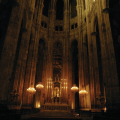ÉGLISE SAINT-EUSTACHE
The plan of this church is organized around a nave with five vessels and a transept
The history of Saint-Eustache is closely linked to that of the Halles, or to be more exact, to that of a market established in the area in the 12th century. On the site of the current church, a first chapel was built by a merchant to thank King Philippe Auguste who had allowed him to collect duties on the goods arriving at the market. Although it was dedicated to Saint Agnes, a name whose memory is still preserved in the crypt on the eastern side, it eventually took the name of Saint-Eustache in 1223, before receiving the official status of parish in 1303 following the donation of relics of the saint by the Abbey of Saint-Denis. From then on, the church was the object of successive alterations and extensions, transformations which give it an aspect mixing the flamboyant gothic style (buttresses, vaults) and the Renaissance style (choir, pillars of the nave). If the building is vast and resembles a cathedral, it remains smaller than Notre-Dame (105 x 43.5 m against 128 x 48 m). On the other hand, the height of its vault is slightly higher (33.46 m against 33 m). Its plan is organized around a nave with five vessels and a transept. Its aisles are doubled and its choir is surrounded by a double ambulatory with 24 chapels housing paintings and sculptures. Its hybrid architecture was strongly criticized in the 19th century, notably by Viollet-le-Duc, who recreated the castle of Pierrefonds and was responsible for the spire of Notre-Dame destroyed in 2019. Among other things, one can admire a triptych by Keith Haring; the tomb of Colbert; the stained glass windows by Antoine Soulignac (1631) and a high altar designed by Victor Baltard. Equally remarkable is its organ, the largest in France, with 8,000 pipes, a virtuoso instrument on which Hector Berlioz and Franz Liszt played. One can also observe in several places the symbol of Eustace: an S and E embraced, a hunting horn and a stag ; animal which according to the legend was at the origin of the conversion of the saint to Christianity. Its 18th century façade houses a sundial and a meridian on the south side. Its portal surmounted by turrets allows visitors to enter. The west portal, built between 1754 and 1772, is based on the one of the Saint-Sulpice church. Many personalities have enamelled the history of this monument. It is known that Louis XIV made his first communion there while Richelieu, Molière and Madame de Pompadour were baptized there. You should also know that every Sunday at the end of the day, organists give concerts there.
Did you know? This review was written by our professional authors.
Members' reviews on ÉGLISE SAINT-EUSTACHE
The ratings and reviews below reflect the subjective opinions of members and not the opinion of The Little Witty.

















A visiter.